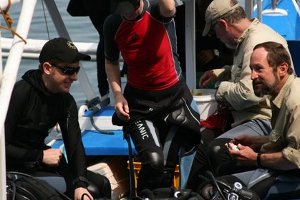 Photo credit: David McGuire, SeaStewards.org
Photo credit: David McGuire, SeaStewards.org
Time passes slowly when days are full. It’s been nearly three weeks into the California Academy of Sciences' 2011 Philippines Biodiversity Expedition. With well over 1000 dives, 100 collection sites and as many new species we have barely scratched the surface of this amazing country of islands. With over 700 islands, volcanoes and rainforests, this island nation has many untold stories and species awaiting discovery and description.
Spending most of my time with the aquatic team, and having an aquatic bent, the undersea world is what I’m most familiar with on this expedition. While the botanists and entomologists are searching Mt. Makiling to the south (and scratching at leeches and mosquito bites), we are exploring the coral reefs, soft-coral forests and rubble pits for nudibranchs, sea urchins, bobbit woms, limpets, sea horses and representatives from the score of other phyla that live in the sea. While there are few insects, there are lionfish, blue-ring octopus and the beckoning spines of Dr. Mooi’s creatures of choice to navigate among.
Dr. Gossliner has upped his new nudibranch count is over 30 undescribed species, and the total number for this colorful and complex shell-less marine snail is over 800! Not to be out done, Chrissy Pietrowski is finding new species and possibly even genera of worms on her dives as she scours the rocks and dead coral. The reefs in this region, located on the Verde Island Passage are abundant and diverse. Scores of coral species color the reef system, enchanting octocorals - the eight-tentacled soft coral Dr. Gary Williams studies - flow and float like vespers in the current. One species common here called Xenia appears to be feeding as it closes and opens its eight-fingered flower-like tentacles. In fact, they are shading the Zooanthellae - the photosynthesizing symbiont who live in their tissues. Like us, too much sun is a bad thing, and this is how this organism protects itself from its own form of coral bleaching.
